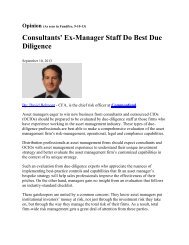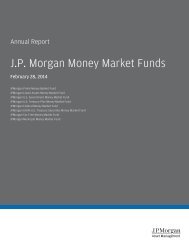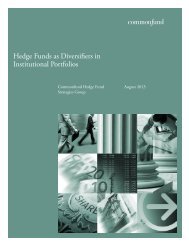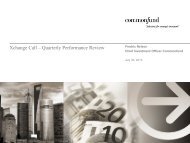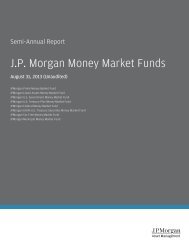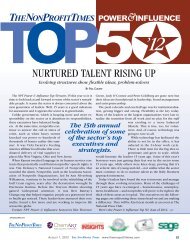The Investment Policy Statement - Commonfund
The Investment Policy Statement - Commonfund
The Investment Policy Statement - Commonfund
Create successful ePaper yourself
Turn your PDF publications into a flip-book with our unique Google optimized e-Paper software.
• How much of the endowment should be spent and how much reinvested?<br />
What rules determine how this amount is calculated?<br />
• To what extent is the fund expected to assist in maintaining the balance sheet<br />
of the institution (for example, by supporting its credit rating)?<br />
In the following sections, we review and discuss each of these issues.<br />
Discussion.<br />
Purpose of the investment pool. Endowments are typically composed of individual<br />
funds given by donors over time, usually to support particular activities or missions<br />
of the organization. Apart from these restricted funds, donors sometimes give with<br />
no restriction as to purpose. In addition, institutions themselves may elect to treat<br />
operating surpluses, unrestricted bequests and other similar amounts as ‘quasiendowment’,<br />
to be invested and spent alongside other endowed funds.<br />
<strong>The</strong>se differing purposes influence the investment strategy for the funds. For example,<br />
a fund dedicated to providing scholarships at a college requires a steady flow of cash,<br />
year in and year out; ideally, the amount should not only remain steady but should<br />
rise with inflation. A fund, on the other hand, that is intended to cover the cost of<br />
awarding an occasional prize every five years does not have the same need for ready<br />
cash. <strong>The</strong>se two funds have different tolerances for year-to-year fluctuation in their<br />
value and for liquidity, among other characteristics; and their asset allocation may,<br />
as a result, be different.<br />
Duration of the pool: perpetual or not? Historically, most donors to endowments<br />
have contemplated a perpetual life for their funds. In recent years, however, some<br />
endowments – including some very large ones such as the Bill and Melinda Gates<br />
Foundation – have been established with a finite life. <strong>The</strong> expected lifespan, or term,<br />
of a fund is an important factor to consider when crafting an investment policy.<br />
In this context, the maintenance of purchasing power, also called intergenerational<br />
equity, becomes an issue of key importance for a perpetual fund. While donors may<br />
occasionally state that intergenerational equity is not a goal for their fund, under the<br />
Uniform Prudent Management of Institutional Funds Act (UPMIFA), which is the<br />
law in virtually all the states, maintenance of purchasing power is assumed to be<br />
the intention of donors in the absence of a specific provision to the contrary. 1 ©2011 COMMONFUND 3<br />
1<br />
For a summary discussion of UPMIFA and its requirements, see Sedlacek and Jarvis, “Endowment Spending: Building a<br />
Stronger <strong>Policy</strong> Framework” (2010), pp. 2-4. For other information about the law, see http://www.upmifa.org.



